The Intel Haswell-E CPU Review: Core i7-5960X, i7-5930K and i7-5820K Tested
by Ian Cutress on August 29, 2014 12:00 PM ESTGaming Benchmarks
One of the important things to test in our gaming benchmarks this time around is the effect of the Core i7-5820K having 28 PCIe 3.0 lanes rather than the normal 40. This means that the CPU is limited to x16/x8 operation in SLI, rather than x16/x16.
F1 2013
First up is F1 2013 by Codemasters. I am a big Formula 1 fan in my spare time, and nothing makes me happier than carving up the field in a Caterham, waving to the Red Bulls as I drive by (because I play on easy and take shortcuts). F1 2013 uses the EGO Engine, and like other Codemasters games ends up being very playable on old hardware quite easily. In order to beef up the benchmark a bit, we devised the following scenario for the benchmark mode: one lap of Spa-Francorchamps in the heavy wet, the benchmark follows Jenson Button in the McLaren who starts on the grid in 22nd place, with the field made up of 11 Williams cars, 5 Marussia and 5 Caterham in that order. This puts emphasis on the CPU to handle the AI in the wet, and allows for a good amount of overtaking during the automated benchmark. We test at 1920x1080 on Ultra graphical settings.
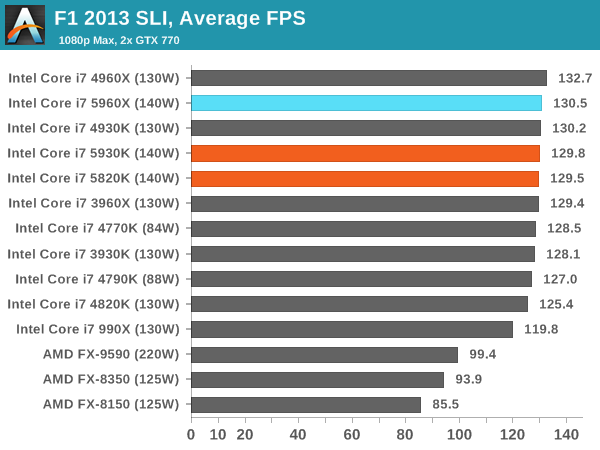
Nothing here really shows any advantage of Haswell-E over Ivy Bridge-E, although the 10% gaps to the 990X for minimum frame rates offer some perspective.
Bioshock Infinite
Bioshock Infinite was Zero Punctuation’s Game of the Year for 2013, uses the Unreal Engine 3, and is designed to scale with both cores and graphical prowess. We test the benchmark using the Adrenaline benchmark tool and the Xtreme (1920x1080, Maximum) performance setting, noting down the average frame rates and the minimum frame rates.
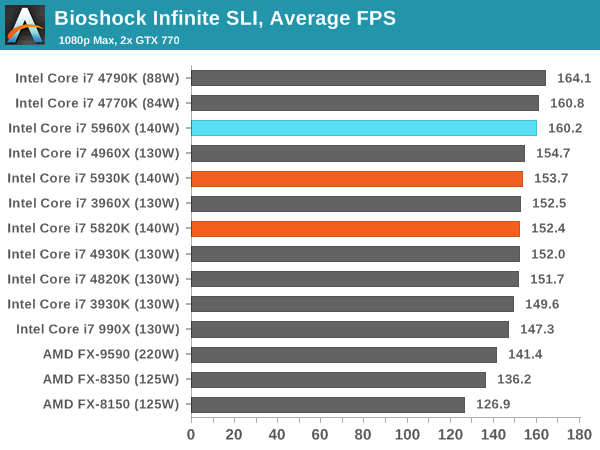
Bioshock Infinite likes a mixture of cores and frequency, especially when it comes to SLI.
Tomb Raider
The next benchmark in our test is Tomb Raider. Tomb Raider is an AMD optimized game, lauded for its use of TressFX creating dynamic hair to increase the immersion in game. Tomb Raider uses a modified version of the Crystal Engine, and enjoys raw horsepower. We test the benchmark using the Adrenaline benchmark tool and the Xtreme (1920x1080, Maximum) performance setting, noting down the average frame rates and the minimum frame rates.
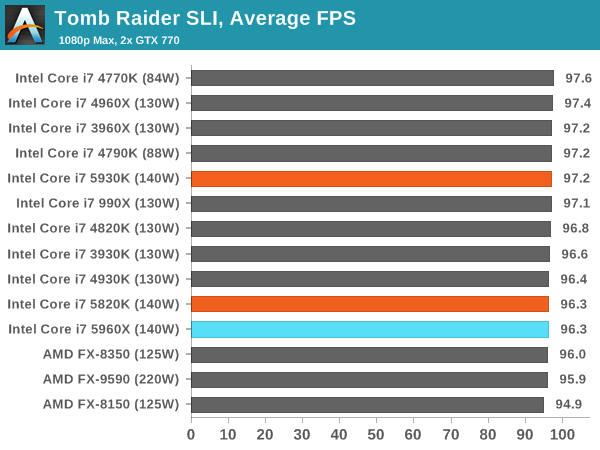
Tomb Raider is blissfully CPU agnostic it would seem.
Sleeping Dogs
Sleeping Dogs is a benchmarking wet dream – a highly complex benchmark that can bring the toughest setup and high resolutions down into single figures. Having an extreme SSAO setting can do that, but at the right settings Sleeping Dogs is highly playable and enjoyable. We run the basic benchmark program laid out in the Adrenaline benchmark tool, and the Xtreme (1920x1080, Maximum) performance setting, noting down the average frame rates and the minimum frame rates.
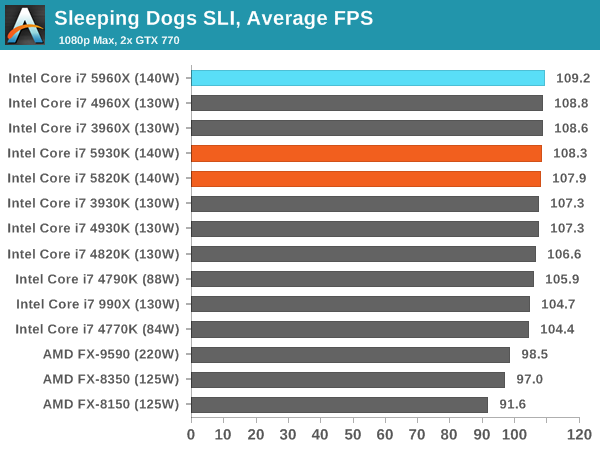
The biggest graph of CPU performance change is the minimum frame rate while in SLI - the 5960X reaches 67.4 FPS minimum, with only the xx60X CPUs of each generation moving above 60 FPS. That being said, all the Intel CPUs in our test are above 55 FPS, though it would seem that the 60X processors have some more room.
Battlefield 4
The EA/DICE series that has taken countless hours of my life away is back for another iteration, using the Frostbite 3 engine. AMD is also piling its resources into BF4 with the new Mantle API for developers, designed to cut the time required for the CPU to dispatch commands to the graphical sub-system. For our test we use the in-game benchmarking tools and record the frame time for the first ~70 seconds of the Tashgar single player mission, which is an on-rails generation of and rendering of objects and textures. We test at 1920x1080 at Ultra settings.
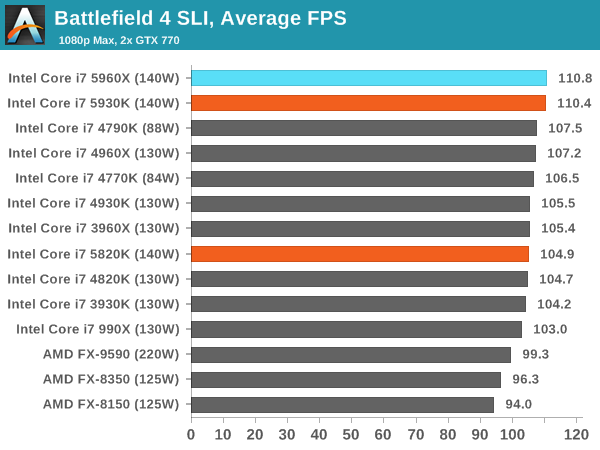
Battlefield 4 is the only benchmark where we see the 5820K with its 28 PCIe lanes down by any reasonable margin against the other two 5xxx processors, and even then this is around 5% when in SLI. Not many users will notice the difference between 105 FPS and 110 FPS, and minimum frame rates are still 75 FPS+ on all Intel processors.















203 Comments
View All Comments
wallysb01 - Saturday, August 30, 2014 - link
This really only makes sense if you don’t have “real” work to do on your computer. Or you only have work that utilizes 1-2 cores. Look at how these bench marks stack up against the 5960: http://www.anandtech.com/bench/product/47?vs=1317. For single threaded stuff its 20-30% faster and for multithreaded stuff its around 3x faster.That’s HUGE if you’re actually putting your computer through a tough workload. Instead of something finishing in month it finishes in 10 days? You don’t think that’s worth it?
And with the i7-920, are you on a motherboard with SATA III, or do you have PCIe expansion for SATA III. For those I/O limited, SATA III with a couple of striped SSDs is a tremendous improvement. Over what was around 5 years ago.
TonyZ - Sunday, August 31, 2014 - link
Same here, run my 2500K at 4.2 on air and I just haven't seen any reason to upgrade as of yet and I've been running it for near 3 years now.... We need something new and groundbreaking...chinmi - Sunday, August 31, 2014 - link
came here to say that :)it may be 10% slower, but it's 90% cheaper.
TiGr1982 - Tuesday, September 2, 2014 - link
These are different classes of hardware even for considerab=bly different purposes.It's like reading the review of Escalade and saying then, "I'll stick to my Focus then" :)
TiGr1982 - Tuesday, September 2, 2014 - link
I meant, comparison of 2500K and Haswell-E is like comparing Escalade and Focus.Crazy forum engine; AT really should look around, notice that better forums are on the web for 10+ years, and ask some web developer to make a normal forum (and not like a student alpha version course project). It's a bit of a shame for such a good website. Sorry for abruptness, but this is indeed the case.
Stas - Wednesday, September 3, 2014 - link
Likewise. 4.4Ghz is plenty. Lived through video card upgrades and still GPU limited with HD7950 o/c.Stas - Wednesday, September 3, 2014 - link
*3 video card upgradesq2klepto - Monday, September 8, 2014 - link
Yup - thankfully new games are almost completely limited by the GPU at high resolutions/quality (1440p/High+). I think my i7 2600k@4.7Ghz and R9 290X can last another year at least, and i can afford to put it underwater instead of upgrading.For normal desktop use, an SSD and 8GB+ of ram will burn thru everything without a prob
imaheadcase - Friday, August 29, 2014 - link
Correction? I think you mean "also featuring 6 cores""The entry level model is a slightly slower i7-5820K, also featuring eight cores and DDR4-2133 support. The main difference here is that it only has 28 PCIe 3.0 lanes. When I first read this, I was relatively shocked, but if you consider it from a point of segmentation in the product stack, it makes sense."
Ian Cutress - Friday, August 29, 2014 - link
Corrected :)